
INTRODUCTION
Scholarship and reporting on this topic tend to view it through the lens of the City as a whole and rarely attempts to look at it from the point of view of a particular neighborhood. Highlighting Southwest Detroit’s volatile past in a manner that aligns with Guide’s unique format is even more complex. Yet to shy away from tackling those challenges would do a disservice to those who truly want to make sense of the neighborhood’s changing landscape.
At this moment, it is beyond the scope of the Guide to generate a comprehensive account of decades of disinvestment or to highlight the pitfalls and progress that characterized revitalization efforts during the years in the last half of the 20th century. What follows thus should be regarded as only a “first installment.” Hopefully, community leaders, policy makers, and researchers can augment the discussion in Part I and explore in more detail key developments that merit being featured in “Part II.”
NOTE: Viewers are encouraged to also review the Guide’s “Autoworkers and their Industry” essay. It examines roughly the same period of time as that which is explored in Part I, but from a very different perspective. That essay tries to illustrate the challenges auto’s “boom and bust” cycles presented for autoworkers and their families.
Part I – THE ARC OF SOUTHWEST DETROIT’S 1ST AUTO CENTURY
When American auto production first flourished – which is to say in the first two decades of the 20th century – land was abundant in southwest Detroit as elsewhere in the city. In the era before the widespread adoption of zoning practices, that meant factories sat adjacent to residential neighborhoods throughout the city. In its earliest days, auto employment was seasonal work, where there was no guarantee that workers would be rehired the next year. Auto work was not just centered in large assembly plants. Parts suppliers and machine shops flourished, supporting thriving commercial thoroughfares with retail shops that served those who were able to put down roots and raise their families. While an increasing number of autoworkers were able to own cars, other workers relied on streetcars for their commute to area factories or to venture to other parts of town.
Military production during World War I and the auto boom that followed increased the demand for workers. Between 1900 and 1920, Detroit’s population more than tripled to nearly a million. By 1930 it reached 1.57 million, en route to its 1956 peak of 1.85 million. Just prior to the crash of 1929, the Employer Association of Detroit’s ‘Labor Barometer’ payroll survey offered this snapshot of employment in the area:
Ford Rouge Complex: 98,939, with 5,137 employed at Lincoln Motors
GM’s Clark St Cadillac: 5,867
GM’s Fisher Body: 16,342**
Graham Paige: 5,700
Timken Detroit Axle: 2,580
Michigan Copper & Brass: 1,240
** This is a citywide total that includes, but doesn’t break out, employees at the Fort Street Fisher Body, Fleetwood, and Ternstedt plants.
In the depths of the widespread unemployment and repatriation of Mexicans during the Great Depression of the early 1930s, few would have imagined that, with the outbreak of World War II, the Motor City would struggle with overcrowding. Not only was housing in short supply, so was vacant land: large-scale industrial expansion could only happen outside the city limits or on a few existing sites.
The appeal of undeveloped suburban land was compelling. Between 1947 and 1958, the Big Three automakers spent $5.9 billion nationwide to build new production facilities. (In 2025 dollars, that would be the equivalent of more than $60 billion.) Some 25 new plants were constructed in metro Detroit, but all were in the suburbs. 124 smaller auto and auto parts manufacturing firms were established in the suburbs between 1950 and 1956, including 55 that did so by moving out of Detroit. By the time of the Korean War, only 7.5% of the $353 million invested in defense equipment and new plant construction in the metro area went to the City of Detroit. Ford, Chevrolet, GM Hydramatic, and Fisher Body established new plants in Livonia.
Employment at the Ford Rouge Complex, just across the city’s border in Dearborn, which still had more than 85,000 workers in 1945, declined to 54,000 workers in 1954 and to 30,000 in 1960. Automation and the geographic dispersion of production accounted for much of the decline. For instance, the Rouge built all Ford and Mercury engines in 1950; but by 1954 that work had been transferred to a new, highly automated plant near Cleveland. The 154 engines produced each hour on the Rouge engine line by 117 workers were now being produced by just 41 workers at the Ohio facility.
Michigan’s auto production peaked in 1956, not coincidentally the same year that Detroit’s population also reached its peak. That year, 150,000 people worked at metro Detroit GM, Ford, and Chrysler plants. Then came the recession of 1957-1958, which in Detroit lasted until mid-1960. Auto production declined in the first year of the recession by 30%. Although the industry’s output fully recovered by the mid-1960s, employment never reached its earlier levels in Detroit -- nor in its suburbs, for that matter. The number of production workers employed at Detroit manufacturing sites fell 47%, while it increased 31% in suburbs (though not all the way back to their 1956 level).
In these decades, employees at major Detroit auto plants relocated to suburban communities, dramatically shifting the demographics of Southwest Detroit. Area auto plants sustained a range of commercial activity in businesses that were owned by neighborhood entrepreneurs and which employed area residents, in addition to contributing significantly to the City’s tax base.
The Ternstedt facilities were shuttered when they were consolidated with other operations in 1984. Cadillac production was moved to the new Detroit / Hamtramck Assembly in 1985, while production of other GM products continued at the Clark Street plant until operations there ceased in 1993. Some 4,500 Fleetwood workers were laid off when production was transferred to a Texas facility in 1987. The impact on Southwest Detroit was devastating for many community residents and businesses.
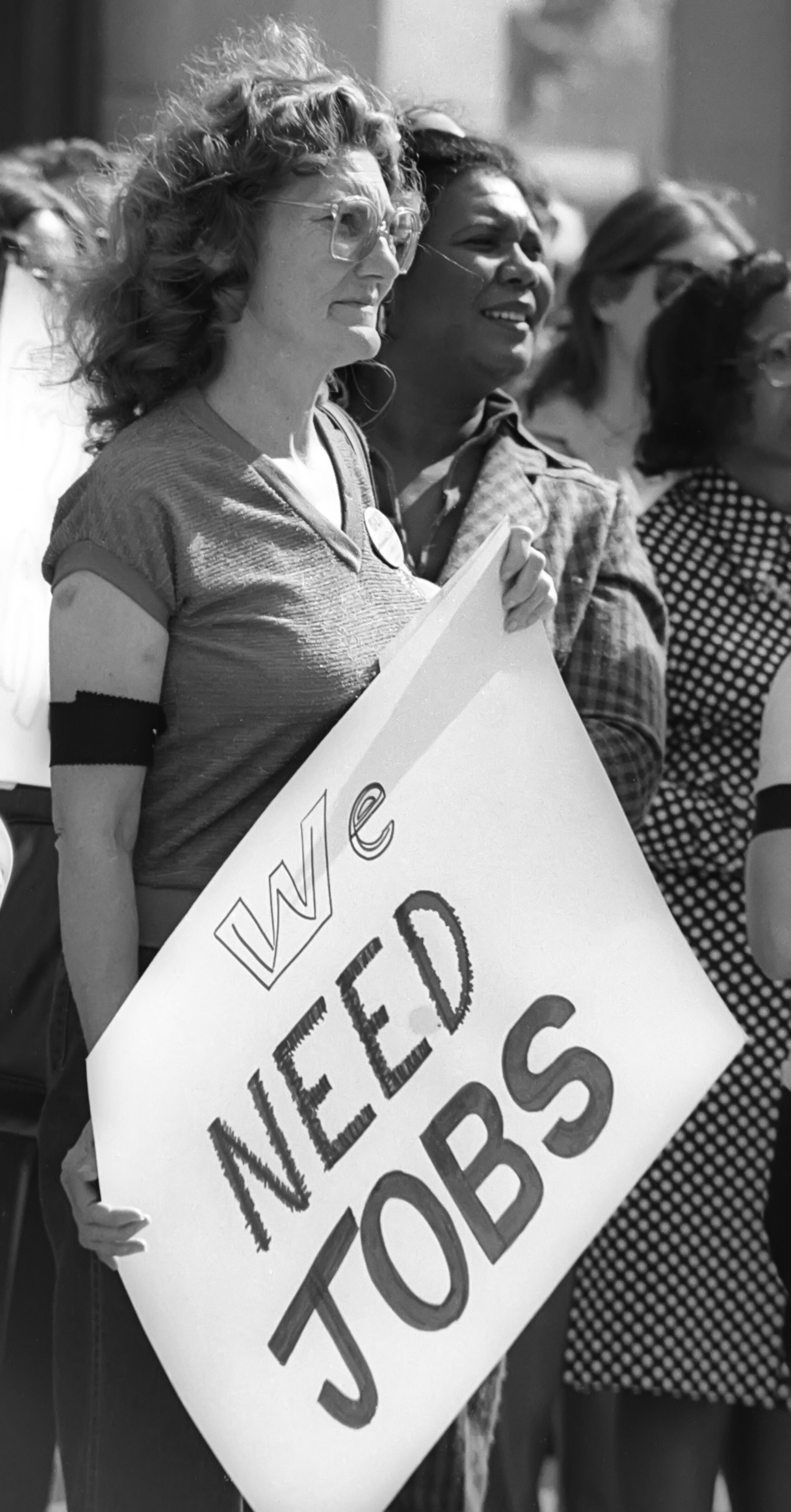 Michigan Avenue Community Organization Protest at General Motors Shareholders Meeting (1981)
Michigan Avenue Community Organization Protest at General Motors Shareholders Meeting (1981)
By 2010, GM, Chrysler and American Axle (which has now shut down its remaining Detroit factory operations) -- the only significant auto manufacturers still in the city -- employed just 11,600 workers.
Decades of discriminatory practices that restricted access to residential mortgages and home improvement loans in the City compounded the impact of state and federal policies that subsidized the growth of interstate highways and suburban housing, greatly facilitating both residential and industrial relocation out of cities into suburban and rural areas. The dislocation arising from the construction of the Lodge, Chrysler, and Reuther freeways in their early years unfolded with little regard to the communities it impacted. Southwest Detroit’s Mexicantown neighborhood was literally cut into two segments by the Chrysler expressway that opened in 1964. It was not until that freeway’s 2010 massive renovations that a pedestrian bridge would symbolically reconnect Bagley Avenue, one of the community’s main commercial thoroughfares.
In many respects, the City was left to fend for itself with a dwindling tax base and limited tools with which to combat the economic tsunamis that accompanied economic downturns of the late 1950s and the 1980s. While not front and center in the debates about Detroit’s 2013 bankruptcy, these trends ought to be recognized as contributing factors.
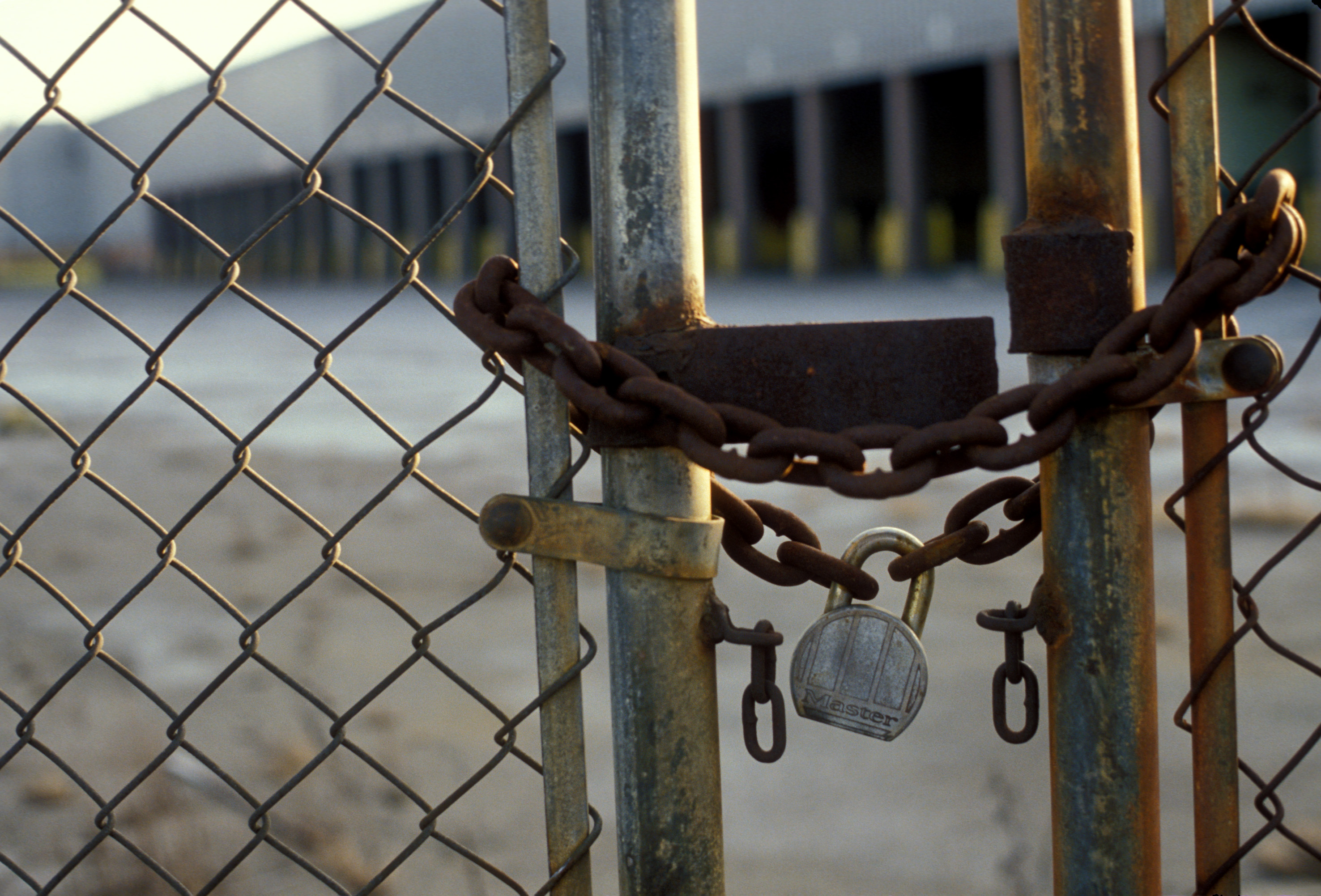
A broader lens is also needed to gain perspective on the national political currents of this era. The conservative movement that sought to rollback Roosevelt-era New Deal policies after World War II championed the relocation of industry to “right to work” states in the Sunbelt. Reinvigorated in the Nixon and Reagan eras, it continued to undermine both the social safety net and the ability of unions to secure a middle-class standard of living for their members and their neighbors. The absence of national industrial policies that might have buffered “rust belt” communities from unfettered market forces arising from automation, plant modernization and relocation, and global competition didn’t occur in a vacuum. Some may be surprised to learn that what follows are the remarks of President Eisenhower: they represent a benchmark of how the dramatically the terms of the social contract shifted in the decades that followed.
"Today in America, unions have a secure place in our industrial life. Only a handful of reactionaries harbor the ugly thought of breaking unions and depriving working men and women of the right to join the union of their choice. I have no use for those -- regardless of their political party -- who hold some vain and foolish dream of spinning the clock back to days when organized labor was huddled, almost as a hapless mass. Only a fool would try to deprive working men and women of the right to join the union of their choice."
-President Dwight D. Eisenhower, 1952
It became fashionable, particularly in the early years of the internet, to highlight boarded-up storefronts, abandoned houses and vacant lots, derelict factories and landmarks. Few referenced the economic forces responsible for those vistas, the human and economic toll those hard times took on the community, or the resilience of those committed to charting its future. The wave of investments that Southwest Detroit has seen in recent years certainly offers a far more promising counterpoint to images of “urban ruins.” Whether the area’s next century can fulfill the promise that Detroit’s auto century provided to past generations, though, is a very different matter. Hopefully, an appreciation of the neighborhood’s past can help inform the vision of those who will chart its future.
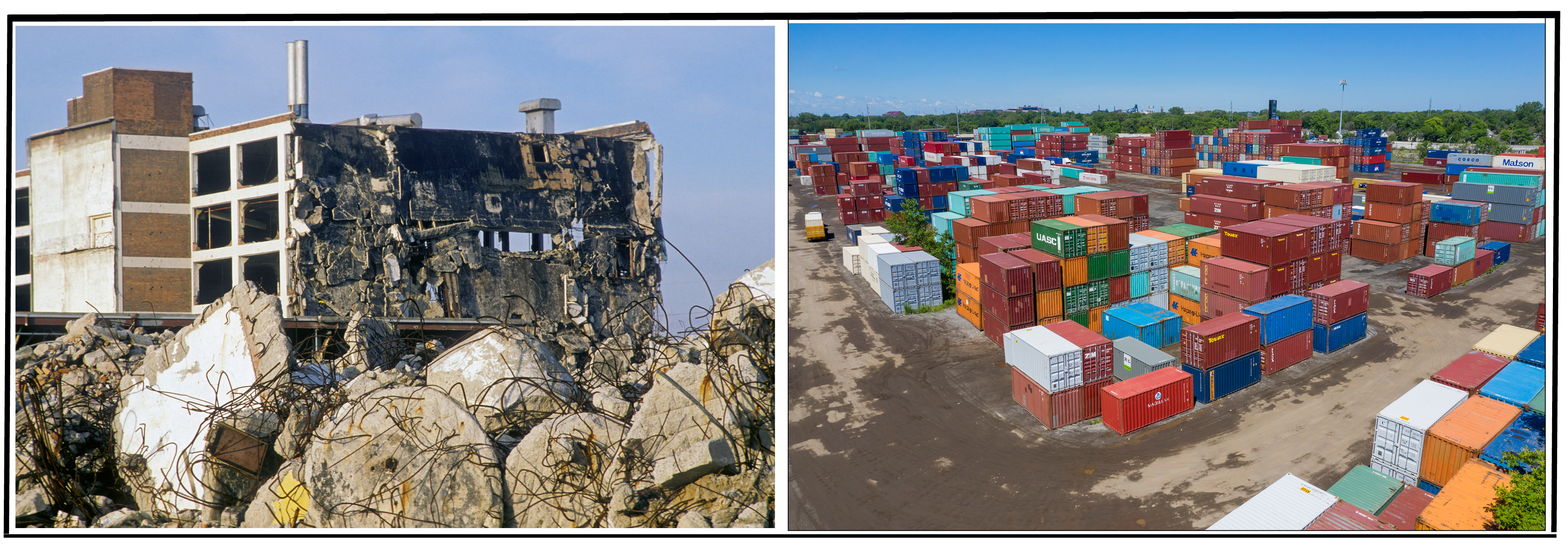 Left Fisher Body Fleetwood Plant Demolition(1992); Right ContainerPort Group Detroit, at the former Fleetwood plant site (2019)
Left Fisher Body Fleetwood Plant Demolition(1992); Right ContainerPort Group Detroit, at the former Fleetwood plant site (2019)
Click to View
Dr. Thomas Klug’s ”The Deindustrialization of Detroit” essay that originally appeared in “Detroit 1967: Origins, Impacts, Legacies,” a 2017 publication edited by Joel Stone. This account also traces the dramatic shifts that unfolded on Detroit’s east side during this period.
Dr. Thomas Sugrue’s essay “Moving Out: Decentralization and the Decline of Urban Factories” is just one of several posted to the “From Motor City to Motor Metropolis: How the Automobile Industry Reshaped Urban America” part of the University of Michigan–Dearborn’s “The Automobile and American Life and Society” initiative.
Part II – REFLECTING ON KEY MOMENTS
As suggested in this essay’s introduction, we hope that other contributors can assist the effort to develop this section. There’s an opportunity to explore in more detail the challenges confronting auto suppliers and manufacturers, expand our discussion of minority suppliers, and trace the evolution government planning and community engagement in revitalization efforts. We’d also like ideas about how best to introduce the Gordy Howe International Bridge, the Ralph Wilson Centennial Park, and other recent developments in the community that certainly reflect impactful investments, but aren’t as focused on the auto industry as most of the Guide’s content.
Here’s our initial list of developments, firms, and events that could be explored in more detail.
Public Sector Initiatives: Oakwood Housing Project (1945), Lodge, Chrysler, & Reuther freeway construction, Detroit Intermodal Freight Terminal, Clark Street Technology Park, and Gordie Howe International Bridge
Private Firms: Ford Rouge Powerhouse Explosion, Global Automotive Alliance, Guardian Industries, Ideal Group, LM Manufacturing LLC (formerly site of Arvin Meritor), Marathon Oil expansion, Piston Automotive
The discussion that follows demonstrates how Part I’s narrative could be enriched by additional research into and posts highlighting items from our list.
West Side Industrial Project – Until 1954 the only federal funds available to cities in the were for slum clearance, not for industrial redevelopment. In 1957, the Detroit City Council voted unanimously to redevelop much of what was Corktown into an urban industrial park for light manufacturing, trucking, and office-based businesses. While lacking the large land parcels needed for huge factories, the park could still take advantage of its proximity to rail lines and the emerging network of freeways that brought trucking into parity with rail.
This “urban renewal” effort displaced a good deal of the Maltese and Mexican communities in Corktown and sparked a spirited 15-year opposition by neighborhood residents, who took exception to the area’s condemnation as “slum property.”
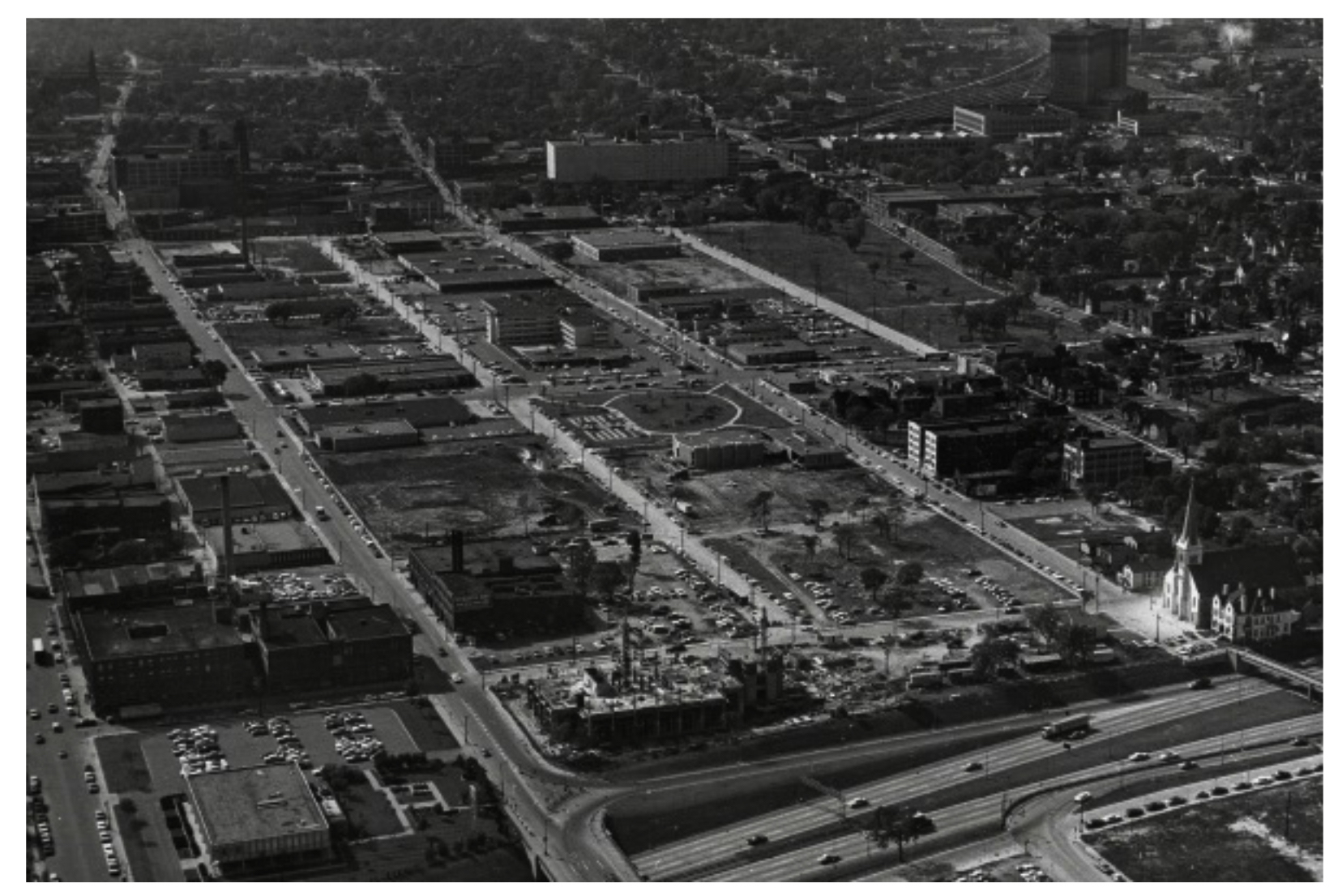 Aerial view of the West Side Industrial District (1966)
Aerial view of the West Side Industrial District (1966)
Ultimately, 75 acres of land were cleared in the project’s first phase and another 92 added in 1963. The project boundaries ran south of Abbot to West Jefferson, between 14th Street and the Lodge Freeway. The land amassed represented only 6.5% of the total acreage needed to replace what were regarded as ”significantly deteriorated” industrial facilities” in 1956. This initiative was to be the City’s first of several relatively unsuccessful attempt to undertake a major industrial redevelopment projects prior to 1981, when land was assembled for the GM Poletown plant.
Going forward, the Guide team would like to see how the following account can be complemented by research that examines how the Maltese and Mexican community engaged in the opposition to the project.
Click to View
Detroit Urbanism blogger Paul Sewick’s article Ethel Claes and the Westside Industrial Project
Ford Rouge Complex –This discussion of the “decentralization” of the Motor Building operations attempts to explore related dynamics and offers a window into the complex politics of this era.
Insofar as the UAW was recognized there less than a year before the outbreak of World War II, labor-management relations in a peacetime economy were largely uncharted terrain. Among industry leaders, a prevailing view held that Detroit represented the most “unpredictable” and “mercurial” labor market in the country.
Between 1946 and 1949, just years before the transfer of Motor Building operations, the company refused to honor existing plant-level agreements on production standards, echoing a return to the harsh practices of the pre-UAW era. The union, in return, authorized strikes to force management to establish production standards in writing and to compel plant foremen and managers to abide by national and plant contracts. One indicator of worker sentiment on this matter was the lopsided vote that authorized the 1949 strike -- 31,926 for vs. 4,400 against. A 24-day strike against “speed-up” was settled in May of that year when management agreed it would not change line speeds in the course of any given workday. However, it took a three-day arbitration hearing to rule that the company had the right to adjust line speeds on “any given day” but that any upward adjustments would now merit the addition of relief workers to help workers whose daily workload would be increased beyond the standard specified in agreements.
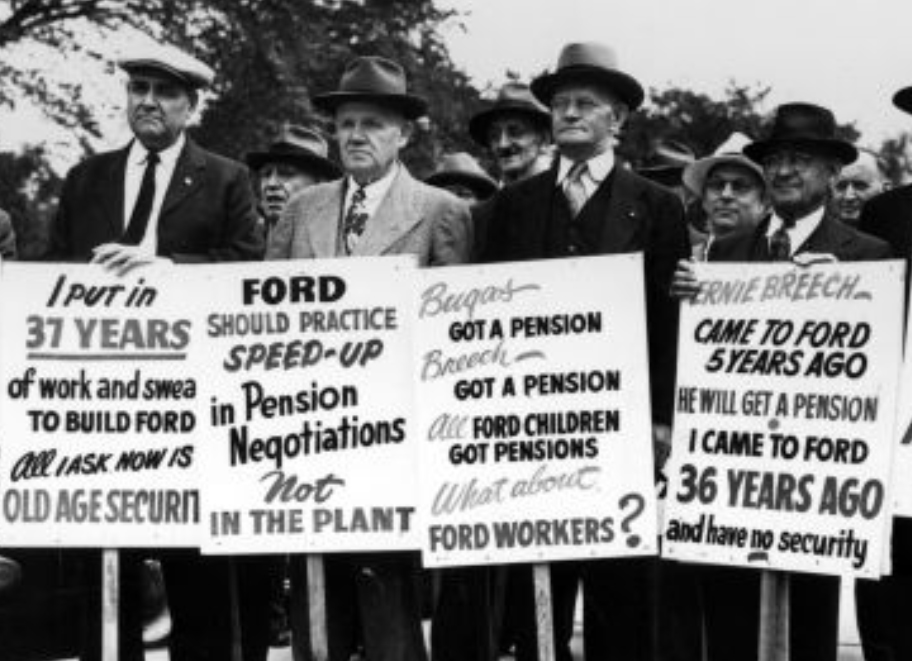 UAW Ford 1949 Strike Picket Line
UAW Ford 1949 Strike Picket Line
The transfer of motor building and foundry operations hit hard the two units with large numbers of African American workers, whose militant leadership was often at odds with both management and the International UAW. Immediately following World War II, Rouge workers represented 57% of UAW membership at Ford; a decade later, they comprised just 30%.
In the ensuing 30 years, work previously done at the Rouge went to other Ford facilities, and then later was outsourced to suppliers – many of them non-union, including more and more of them in the South and in Mexico.
By the 1980s, that dispersion of Detroit/Dearborn work, along with market share losses to VW and, later, to Asia-based automakers, presented a major challenge to both the Big Three and to its UAW-organized workforce. In a rather ironic twist, Asian automakers championed “just in time” delivery of parts to the assembly line as central to its efforts to increase productivity. In fact, the highly efficient centralized manner in which materials and components were organized were the initial hallmarks of the Rouge when it was completed in 1928, prior to the waves of decentralization that began in the 1950s and accelerated after the 1980s.
As a result, labor and management spoke openly of new partnerships, with local and national contract concessions (often around “work rules” that restricted certain tasks to workers in particular job classifications) often traded for investment promises. Reflecting this increased labor-management cooperation, in 1999 the company embarked on a $2-billion renovation of the Rouge, led by Chairman William Clay Ford Jr., who sought to establish it as a model of 21st Century industrial sustainability.
Completed in 2005, the renovated Rouge featured the latest in automotive assembly technologies along with advanced solutions for storm water management, onsite energy production, and even soil restoration. Following the 2009 auto recession, employment at the Rouge rebounded to 6,000 production workers. A 2020 infusion of $700 million created the Ford Rouge Electric Vehicle Center that now produces the all-electric Ford F-150 Lighting that complements the F-Series 150 trucks that have been produced there since 1948.
Click to View
The Guide’s Ford Rouge Complex profile that relies on links to the Henry Ford Museum posts as well as a host of videos to augment its short overview of the site’s storied history. Going forward, the Guide team will be assessing how the above account might be incorporated into our revised introductory post.
“Told Their CEO ‘None of the Young People Want to Work Here.’ So Jim Farley Took a Page Out of the Founder’s Playbook,” a 2025 Fortune magazine article featuring Ford Chief Executive Officer Jim Farley’s comments at an Aspen Institute talk, where he spoke of the steps the company took recently that broke with the “two-tier” wage system for new workers that had been a feature of contracts since the 2007-09 recession.
An Economic ‘Frankenstein’: UAW Workers’ Response to Automation, Dr. Stephen Meyer’s article, found on the University of Michigan-Dearborn’s “Auto in American Life and Society” website, describes how the UAW responded to the impact of automation in the 1950s. He focuses on the impact of early automation on collective bargaining at the Ford Brook Park plant in Cleveland.
Closing of Cadillac Assembly – Since 1921, General Motors had been assembling Cadillacs and, briefly, Oldsmobiles, at its million-square-foot Clark Street Assembly Plant, with bodies supplied by the nearby Fort Street Fleetwood Fisher Body plant. In 1987, Cadillac production was transferred to the new Poletown facility and Clark Street closed in1993. The redevelopment effort that led to the establishment of the Clark Street Technology Park and involved minority contractors like the Global Automotive Alliance, the Hispanic Manufacturing Center, and the Ideal Group. While realizing the ambitious early visions of the Technology Park proved challenging and the Hispanic Manufacturing Center failed, the Ideal Group has flourished. Ernst & Young LLP recently recognized its senior leadership as winners in its Entrepreneurs of The Year 2025 Michigan and Northwest Ohio Award (making them eligible for consideration for the Entrepreneur of The Year 2025 National Awards).
In the course of the next year, the staff of El Central Hispanic News, the neighborhood’s bilingual newspaper, will collaborate with the Guide team to create profiles of the Hispanic Manufacturing Center and the Ideal Group while helping trace the Technology Park’s evolution.
Click to View
Detroit Historical Museum’s America’s Motor City Exhibit, an introduction to the signature feature of the exhibit is the final section of the Clark Street Cadillac “body drop” where the finished body was joined to the chassis near the end of the assembly line.
RESEARCH
Ron Alpern
TEXT
Ron Alpern, Dan Luria, Mitch Fleischer
PHOTO CREDITS
Burton Historical Collection, Detroit Public Library
West Side Industrial District
Walter Reuther Library, Archives of Labor and Urban Affairs, Wayne State University
1949 Ford Pickets
Jim West Photography
All remaining images



